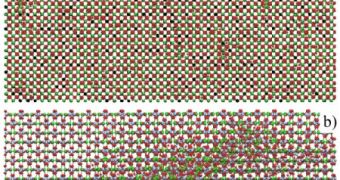Yttria-stabilized zirconia is a well known ceramic material revealed lately as being able to repair defects within its structure, while under the action of high-radiation levels. Computer simulations carried out at the Pacific Northwest National Laboratory showed that the structure of the material can be altered at the atomic level, so that it heals damage determined by radiation through relentless oxygen atom movement.
Most of us might not realize at first the importance of such a material, but it may have wide application in the nuclear energy industry, as well as providing with a material able to withstand the effects of high-radiation levels in nuclear waste storage.
"If you want a material to withstand radiation over millennia, you can't expect it to just sit there and take it, it must have a mechanism for self healing," says Dr Ram Devanathan from the Pacific Northwest National Laboratory.
With the help of the supercomputer located at the Department of Energy's Environmental Molecular Science Laboratory at PNNL and that of the National Energy Research Scientific Computer Center at Lawrence Berkeley National Laboratory, researchers analyzed what happens when yttria and zirconia experience defects in the ceramic structure, while subjected to radiation.
Because yttrium has a smaller electrical charge than that of zirconium, it replaces one zirconium atom in the structure, thus creating an unbalance that is then complemented by oxygen atom emission. The empty spaces determined by the ejection of the oxygen atoms then force an oxygen atom movement, as the remaining atoms continuously try to fill the empty spaces.
"It is like a classroom full of fidgety kids. When the teacher turns her back, the kids constantly jump into empty chairs, leaving their own chairs vacant until another kid leaps into the seat," explains Devanathan.
The researchers tried to simulate what would happen when an alpha particle is emitted. The energy given off during an alpha particle emission is high enough to propel the originating atom in the opposite direction, which can also create defects into the structure. However, in this case the space left behind by the ejected atom is immediately occupied by an oxygen atom, in order to repair the damage and stabilize the structure.
Although the technique doesn't have the power to repair defect clusters within the material, it can isolate certain structure defects, such as those found in zircon. "This research raises the possibility of engineering mobile defects in ceramics to enhance radiation tolerance for applications such as nuclear waste disposal, where the material is expected to resist radiation damage over the millennial time scales," says participant in the study, Dr Bill Weber.

 14 DAY TRIAL //
14 DAY TRIAL //